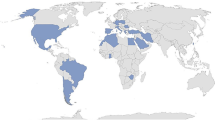Abstract
This review introduces the history of development, organizational structure, funding resources, data collection, and quality control of the Chinese Rheumatism Data Center (CRDC) and summarizes the collection of data. In 2009, Peking Union Medical College Hospital (PUMCH), together with several rheumatism centers, established the Chinese Systemic Lupus Erythematosus (SLE) Treatment and Research Group (CSTAR) to collect data on Chinese patients for the study of SLE disease characteristics. In 2011, CSTAR was extended with the formation of the CRDC at PUMCH with direction from the National Health and Family Planning Commission of the PRC. The CRDC currently includes 300 registration sites and 50 regional sites that have successively begun to collect data on 12 rheumatic diseases, including systemic lupus erythematosus (SLE), rheumatoid arthritis (RA), ankylosing spondylitis (AS), systemic sclerosis, dermatomyositis, Takayasu arteritis, IgG4-related diseases, ANCA-associated vasculitis, gout, polyarteritis nodosa, unclassified systemic vasculitis, and Behcet disease. To date, 17,224 patients have been enrolled in the CRDC. Based on the SLE patients registered in the CRDC, papers investigating basic demographic characteristics and first symptom in Chinese SLE patients, risk factors of pulmonary hypertension, correlations between autoantibodies and clinical manifestations, and factors related to fetal loss have been published. The CRDC is a national registry that provides real-life data to improve clinical decision-making. At the same time, without additional work for the clinician, the CRDC is a powerful research database. The CRDC database provides sufficient information for Chinese clinical studies on rheumatology. Moreover, a mobile device application ensures convenient and efficient data collection without compromising data quality, thereby providing strong evidence-based data for the diagnosis and treatment of Chinese rheumatic patients.




Similar content being viewed by others

References
Sokka T, Krishnan E, Hakkinen A, Hannonen P (2003) Functional disability in rheumatoid arthritis patients compared with a community population in Finland. Arthritis Rheum 48:59–63
Van Vollenhoven RF, Ernestam S, Harjua BJ, Klareskog L (2003) Etanercept versus etanercept plus methotrexate: a registry-based study suggesting that the combination is clinically more efficacious. Arthritis Res Ther 5:R347–51
Kvien TK, Glennås A, Knudsrød OG, Smedstad LM, Mowinckel P, Førre O (1997) The prevalence and severity of rheumatoid arthritis in Oslo. Results from a county register and a population survey. Scand J Rheumatol 26:412–8
Hetland ML (2005) DANBIO: a nationwide registry of biological therapies in Denmark. Clin Exp Rheumatol 23:S205–7
Li M, Zhang W, Leng X, Li Z, Ye Z, Li C et al (2013) Chinese SLE Treatment and Research group (CSTAR) registry: I. Major clinical characteristics of Chinese patients with systemic lupus erythematosus. Lupus 22:1192–9
Tan EM, Cohen AS, Fries JF, Masi AT, McShane DJ, Rothfield NF et al (1982) The 1982 revised criteria for the classification of systemic lupus erythematosus. Arthritis Rheum 25:1271–7
Hochberg MC (1997) Updating the American College of Rheumatology revised criteria for the classification of systemic lupus erythematosus. Arthritis Rheum 40:1725
Li M, Wang Q, Zhao J, Li Z, Ye Z, Li C et al (2014) Chinese SLE treatment and research group (CSTAR) registry: II. Prevalence and risk factors of pulmonary arterial hypertension in Chinese patients with systemic lupus erythematosus. Lupus 23:1085–91
Li J, Leng XM, Li ZJ, Ye Z, Li C, Li X et al (2014) Chinese SLE treatment and research group registry: III. Association of autoantibodies with clinical manifestations in Chinese patients with systemic lupus erythematosus. J Immunol Res 2014:809389
Tian XP, Li M, Ye ZZ, Zhang X, Liu SY, Wu LJ et al (2014) Related factors of fetal loss in Chinese women with systemic lupus erythematosus: data from Chinese SLE treatment and research group (CSTAR) registry IV. Int J Rheum Dis. doi:10.1111/1756-185X.12542
Petri M (1997) The effect of race on the presentation and course of SLE in the United States. Arthritis Rheum 40:S162
Wang F, Wang CL, Tan CT, Manivasagar M (1997) Systemic lupus erythematosus in Malaysia: a study of 539 patients and comparison of prevalence and disease expression in different racial and gender groups. Lupus 6:248–53
Alarcón GS, McGwin G Jr, Petri M, Reveille JD, Ramsey-Goldman R, Kimberly RP (2002) Baseline characteristics of a multiethnic lupus cohort: PROFILE. Lupus 11:95–101
Cervera R, Khamashta MA, Hughes GR (2009) The Euro-lupus project: epidemiology of systemic lupus erythematosus in Europe. Lupus 18:869–74
Pons-Estel BA, Catoggio LJ, Cardiel MH, Soriano ER, Gentiletti S, Villa AR et al (2004) The GLADEL multinational Latin American prospective inception cohort of 1,214 patients with systemic lupus erythematosus: ethnic and disease heterogeneity among “Hispanics”. Medicine (Baltimore) 83:1–17
Acknowledgments
The authors wish to thank Yuepeng Guo and Changjun Wang for their enormous medical support while working at the Medical Affairs Department of Xian Janssen. Both gave professional suggestions regarding the CRDC platform and this publication. There is no funding support for this review.
Disclosures
None.
Author information
Authors and Affiliations
Corresponding author
Rights and permissions
About this article
Cite this article
Li, M., Tian, X., Zhang, W. et al. CRDC: a Chinese rheumatology research platform. Clin Rheumatol 34, 1347–1352 (2015). https://doi.org/10.1007/s10067-015-3003-1
Received:
Accepted:
Published:
Issue Date:
DOI: https://doi.org/10.1007/s10067-015-3003-1



